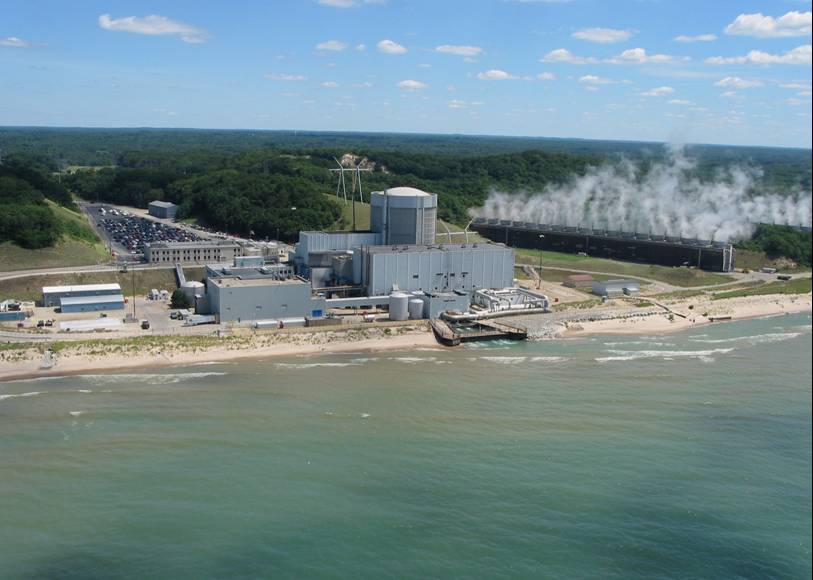Entergy's Palisades leaks 79 gallons of radioactive water into Lake Michigan, forced to shut down
 May 7, 2013
May 7, 2013  Entergy's Palisades atomic reactor on the Lake Michigan shore in southwestern MIAs reported by the Holland Sentinel, Entergy's Palisades atomic reactor has yet again sprung a leak, this time spilling 79 gallons of supposedly "very slightly radioactive water" into Lake Michigan, the headwaters of 20% of the world's surface fresh water, and drinking water for 40 million people downstream.
Entergy's Palisades atomic reactor on the Lake Michigan shore in southwestern MIAs reported by the Holland Sentinel, Entergy's Palisades atomic reactor has yet again sprung a leak, this time spilling 79 gallons of supposedly "very slightly radioactive water" into Lake Michigan, the headwaters of 20% of the world's surface fresh water, and drinking water for 40 million people downstream.
Such unintentional leaks -- which have included tritium leaks into groundwater -- increase the radiological burden already borne by the public and environment in the downwind and downstream area, due to "permitted," intentional, "routine radiation releases" from Palisades (note that the photo of the water discharge pathway in Beyond Nuclear's pamphlet was taken at Palisades itself!).
Entergy and NRC spokespersons' repeated claims of no safety significance to the public flies in the face of decades of findings, as by the National Academy of Science (most recently in 2005), that any exposure to radioactivity, no matter how small, carries a health risk of cancer, and that these health risks accumulate over a lifetime.
U.S. Representative Ed Markey (D-MA) made public the serious nature of this particular leaking tank in June 2012. His information came from very courageous Palisades whistleblowers, and their attorney, Billie Pirner Garde. The leak, from the 300,000 gallon Safety Injection Refueling Water (SIRW) storage tank located directly above the control, began in mid-2011, and was flowing through the ceiling, and being captured in buckets in the safety critical control room, full of electrical circuitry and equipment that cannot get wet. The leak was concealed not only from the public and media, but even from the NRC's own Chairman, Greg Jaczko, as he toured Palisades on May 25, 2012. NRC later granted Entergy an exemption in 2012 to allow continued operations despite the degraded condition of the SIRW storage tank.
In recent weeks, Beyond Nuclear learned from NRC officials that the now two-year-old leak has continued at a 0.5 to 1 gallon per day rate. But Saturday's leakage rate, which forced the reactor to shut down, was at 90 gallons per day, as documented in NRC's event notification report. Palisades' SIRW storage tank, just like the rest of the plant, is 46 years old, and obviously showing severe signs of "breakdown phase" age-degration, of increasing risk.
The Detroit Free Press, Enformable Nuclear News, Kalamazoo Gazette, Michigan Radio, WSJM Radio, WKZO Radio,WWMT TV-3 Kalamazoo, Detroit News, and WOOD TV-8 Grand Rapids have reported on this story.
Beyond Nuclear issued a media statement, challenging flippant Entergy and NRC claims that this leak carries "absolutely" no risk to human health and safety. NRC's Region 3 spokeswoman has been exposed making false claims regarding radioactivity leaks more than once at Midwestern reactors in just the past year, prompting the demand for an investigation by a member of Congress. Last year, U.S. Rep. Dennis Kucinich (D-OH) demanded an NRC investigation into Mytling's downplaying of a reactor leak at the troubled Davis-Besse atomic reactor near Toledo. In addition, Chicago watchdog group Nuclear Energy Information Service, via a Freedom of Information Act Request to the State of Illinois Dept. of Nuclear Safety, documented that Mytling's flip assurance -- that a radioactive steam leak at the Byron atomic reactor, in Jan. 2012, must have contained exceedingly low levels of hazardous radioactive tritium, as radiation monitors had not detected any -- was baseless and misleading, as no real-time tritium monitoring capability existed at the plant. Similar questions must now be asked of Mytling's questionable assurances that radioactivity levels in the water leaked into Lake Michigan were below detectable levels. Are there radiation monitors in place to verify such flip assurances?
 admin
admin
The St. Joe-Benton Harbor Herald Palladium has reported on this story:
'...Anti-nuclear crusader Kevin Kamps of the organization Beyond Nuclear said that given the NRC's history of allowing radioactive water to go into Lake Michigan, he was "shocked but not surprised" about Saturday's spill.
"They do have permits to dump radioactive water regularly to get rid of it, and the NRC lets them," Kamps said. "They rely on the whole 'dilution is the solution' mind-set. The NRC is complicit. They allowed Entergy to use this leaky tank in a degraded condition."'
WSBT TV 22 South Bend also reported on this story:
' “This plant is an accident waiting to happen, and it really needs to be permanently shut down before the worst happens there,” said Kevin Kamps of Beyond Nuclear.'
Huffington Post has also reported on this story.
Fairewinds Energy Education plans to post a podcast interview with Beyond Nuclear's Kevin Kamps on May 8th.
 admin
admin
Kevin Hurley, host of the Fairewinds Energy Education pod cast, and Fairewinds Associates, Inc's Chief Nuclear Engineer, Arnie Gundersen, invited Beyond Nuclear's Kevin Kamps onto their May 8th episode, entitled "Nuclear Regulators Stick Their Heads in the Sand," to discuss the latest leak (of 80 gallons of radioactive water into Lake Michigan) at Entergy's problem-plagued Palisades atomic reactor (see first half of broadcast).
 admin | Comments Off |
admin | Comments Off | 



